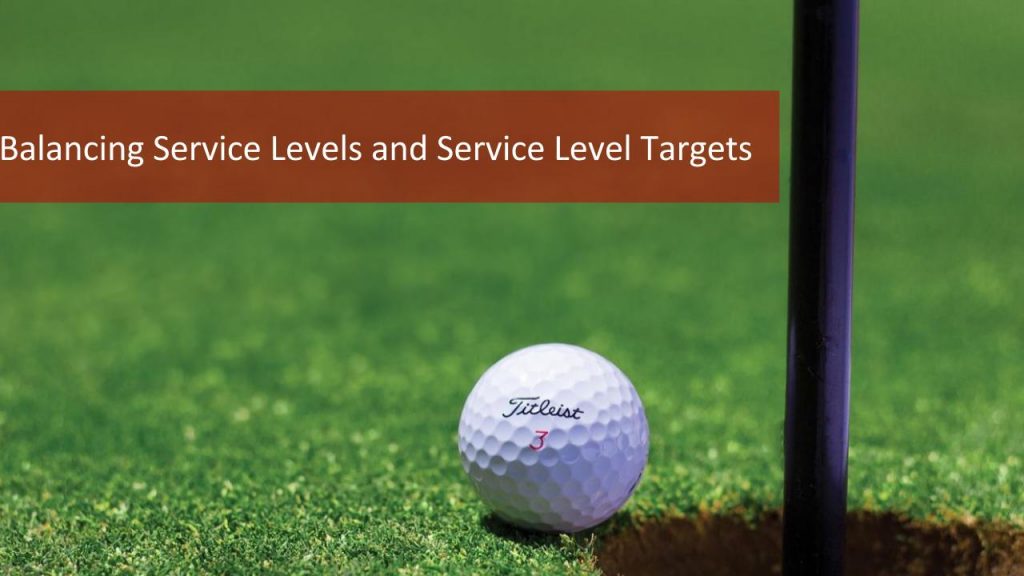ITIL training defines service level targets that are required by the business and that there are service levels that can be provided by the IT Service provider. To reach consensus on what can realistically be achieved, the service level targets of the business need to be lined up against the service levels that the IT department can commit to. The business and IT Service provider negotiate on the service levels that need to be met and this is officially signed off on a service level agreement (SLA). This is all part of the ITIL Service Design Stage of the ITIL Lifecycle.

The Role of the 4 P’s of ITIL Service Design in Service Levels
ITIL foundation training also defines the ITIL 4P of Service Design. These are:
- People
- Processes
- Products and Technology
- Partners and Suppliers
The 4 Ps of service design play an important role in negotiating an agreement in terms of service level targets and service levels. In order to design a service, you need all these resources defined in the 4 Ps in an IT service provider organization. IT services are designed with the help of the capabilities originating from these 4 Ps.
Note that these resources of the IT service provider will define the upper limits of the organization in terms of what can be delivered in terms of service levels. For instance, the number of the administrators, the maturity of the processes, number and power of the services and also constraints and abilities of the partners and suppliers will all determine the service levels.
If the business requirements exceed the upper limits of the service levels, negotiations need to take place to either procure more resources or to trim down the business requirements.
What are the Constraints in Service Levels?
Let’s consider that a telecom operator provides up to date finance news for its subscribers. If there will be only one server serving this service and if this server can serve up to one hundred thousand users, there will be a problem when more than one hundred thousand users demand this service.
Or similarly, if you are using a service of a partner when providing this service, and if your partner can serve up to fifty thousand users maximum, regardless of the number of the servers you will configure, because of the constraint on the partner’s side, you won’t be able to serve more than fifty thousand users.
So, all of these P’s of the Service Design determine the fences of service levels. Note that service levels are measured and reported progressively in an IT Service provider. And on the other side of the coin, the business comes with the requirements for services that will be provided.
For instance, service should be provided to one hundred thousand users and minimum 98% availability should be reached. These are two sample business requirements about a service and for sure there can be lots of requirements from the business. And these are service level targets that need to be met by the IT Service Provider’s service levels.
Balancing Service Levels and Service Level Targets
The business explains its service level targets for a service and the IT Service provider evaluates these requirements against the service levels that it can deliver upon. If the IT service provider can meet these requirements with its current resources and capabilities, an SLA is signed off between the business and IT service provider.
If the IT service provider cannot meet the required service level target, either the business should decrease its service level target expectations or the IT service provider should improve its service levels by increasing its resources and capabilities in order to meet the required service level target. This will bring extra costs to the IT service provider and to the organization. Negotiations between the business and the IT service provider take place and they meet on a service level target that can be realistically met with the current or somewhat increased IT service levels and an SLA is signed off.

During the Service Design phase of the ITIL Service Lifecycle, it is important that the business and the IT department has a clear idea of what needs to be done and what can be done. If the IT department’s service levels are not up to the job, the service level targets must be re-evaluated along with the IT department’s capabilities in terms of people, processes, products and partners. These 4 P’s are where service levels are determined and should be the main consideration when deciding whether the IT department has sufficient resources to meet the business demands.
Weighing Up Costs and Benefits for Increased Capabilities of Service Levels
Similarly, if the business wants to launch a new service that will potentially create great revenue, the business must face the fact that the IT department’s service levels may not be able to deliver on their service level targets as is. They must be willing to invest in more people, better processes, better products and perhaps outsourcing to better partners. All of this will cost money and the potential benefit of the service delivering at the set service level targets must be weighed up against the cost of establishing sufficient service levels on the IT department’s side. The business might not always be willing to spend extra dollars on service levels, so it is the IT service manager’s job to thoroughly explain why new capabilities are needed to complete the job according to the business requirements. A good quality online free ITIL training will briefly explain how to improve the balance service levels and the targets.
The IT service manager must also know what capabilities can be sacrificed from other services that bring in less revenue. Sometimes, excess resources are spent on a service because of an over-estimation of the resources needed to deliver on its service level targets. Sometimes the service level targets are unnecessarily high and exceed what is really needed from that service. Capabilities and resources can be shaved off from such services to create service levels that will meet the service level targets of the business for the new service which is expected to bring in a lot of revenue to the company.
Review by: Rose Cole

6 thoughts on “The Dance Between Service Levels and Service Level Targets”
Comments are closed.